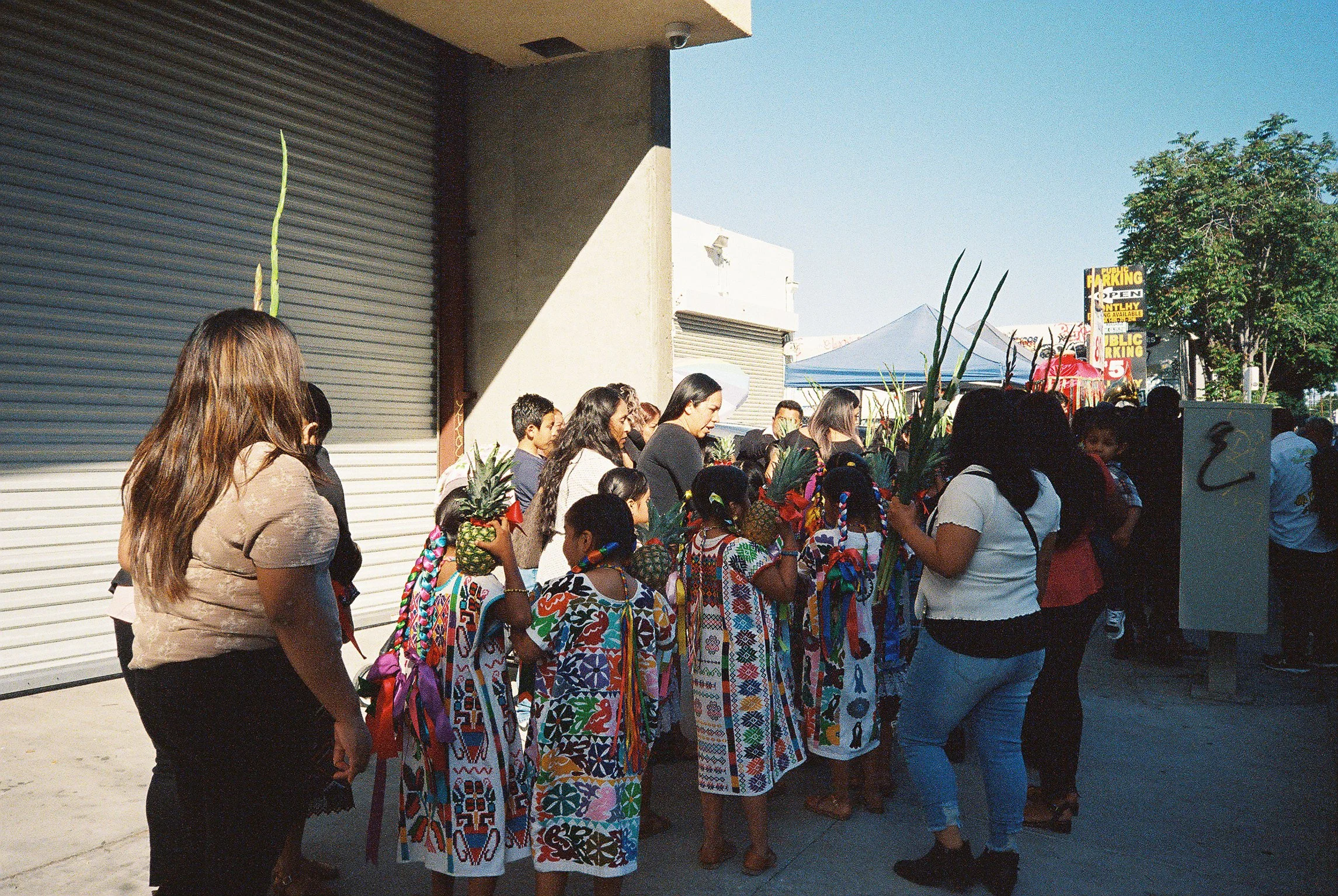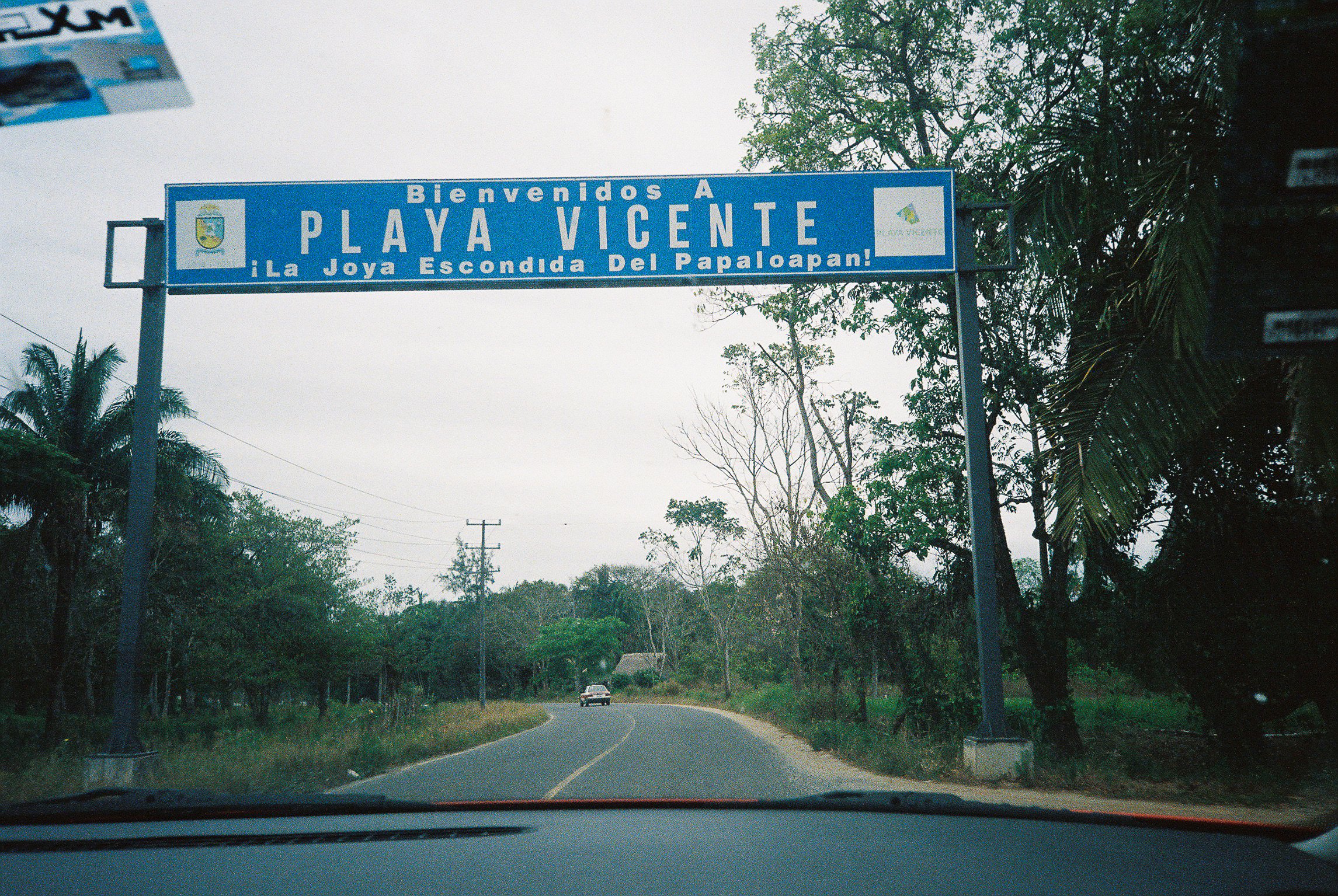
Kimberly Espinosa - Memories That Make Home
About the Exhibition: I grew up in Koreatown with Bene’ Xtidxa (Zapotec) parents who told stories about what home back in Veracruz, Mexico was like. Often, I saw parts of their stories reflected in our experiences while living in Koreatown, especially in the celebrations and community fundraisers we went to that mirrored the same network of intergenerational support. At these events, jarabes play in the background by La Banda de Santa Cecilia de Los Angeles, there are danzas, and traditional foods from our pueblo are also served. Many relatives also reconnect during this time as it is usually the only time they are able to get together outside of work. These community fundraisers, commonly referred to as kermeses, are an important element of building solidarity and mutual aid networks. At kermeses, folks pitch in to help raise funds for an individual when faced with financial distress, for various community festivities held throughout the year, and sometimes, to also support community-based projects back in our hometown.
This year, I had the blessing of visiting our homeland where I felt many of my parent’s memories come alive. Memories like coming together to support one another as a community while honoring traditions like playing music, sharing dialogue with one another, and eating comfort foods. As I prepare to move and experience new spaces at college, I find comfort in being able to remember, celebrate, and honor the memories that make home. This exhibition is a documentation of my memories with family, community members, and places existing across Koreatown and the greater Los Angeles area, an extension of our hometown in El Nigromante, Playa Vicente, Veracruz.
About the Artist: Kimberly Espinosa (she/lebe’) is a Zapotec community organizer and photojournalist from Koreatown, Los Angeles. Their work highlights connections to family history, youth culture, and community solidarity.
Growing up in a community where storytelling exists as a prominent method of preserving ancestral knowledge, she understands the importance of practicing this in the work she documents. During her high school experience, Kimberly was a student with Las Fotos Project and the Koreatown Storytelling Program. She developed intergenerational interviews along with photographs of community members who spoke about their hometown memories, experiences as part of the working class, and their dreams for a better world. This fall, Kimberly will be attending Northwestern University as a first-year student in the Medill School of Journalism.
Mentors: Brittany Bravo and Piper Sellers




Sones y Jarabes, Left
Collective Joy, Middle Left
The Bull, Middle Right
“Old Love”, Right
Photos from the annual Fiesta de San Marcos.
I have many fond memories of our community events growing up. When I was in elementary school, mom had a workplace accident that did not allow for her to return to her daily activities, such as working. My family and I were encouraged by our relatives who held a fundraiser to raise funds in support of my mom. I was probably six when this happened, but it is still a memory that I value very much. Celebrations and community fundraisers would not be possible without the collective support folks provide.
La Banda de Santa Cecilia
La Banda de Santa Cecilia is an intergenerational band of twenty-four members based in the Los Angeles area.
There is something so special about listening to the band play. Every time I hear jarabes, it is like I am feeling my dad’s presence around. He would often dance to jarabes when attending festivities. When I went to Veracruz, the same music played at his funeral. I am not sad, but rather happy to hear this music. Music by the band is a celebration of our community’s existence. Music that heals my heart and of those who miss home.
“Flor de Piña”
A mother and daughter sharing a moment before starting their performance of “Flor de Piña.”
I always smile from ear to ear seeing the children of our relatives participate in traditional dances. It reminds me of mom and her stories of dancing folklorico in Mexico. Mom gets especially excited when she hears Flor de Piña because it's a dance she knows from Tuxtepec, a region close to our hometown. The baile to “Flor de Piña” will hold a special place in my heart.


By Community
Community events would not be what they are without our traditional foods and the amazing people making them! Patricia or “Paty” as many know her, (photographed on the left) is one of the many women in our community who I admire and appreciate so much. She is President of the La Banda de Santa Cecilia. During the time this photograph was taken she was helping make tlayudas at the kermes to support the band. My favorite!




Preserving The Moment, Left
Uncle Quino & Dayra, Middle Left
Music From the Heart, Middle Right
“Let the Dancing Continue”, Right
The intergenerational connections within our community are so powerful. I think about all the stories and traditions that have continued to be preserved through the practice of storytelling, taking place in many forms and among different generations. Starting a live recording of a community gathering to share with those who cannot be there physically, having time to hold dialogue with each other, playing music as a celebration, and dancing to jarabes are just a few ways we honor our ancestors and homeland.
Growing Up in Koreatown
The band playing in front of “Koreatown” signage.
My experience as a kid growing up in Koreatown will always be a blessing to me. Going to a high school where some students in my senior class were also family or from other pueblos in Oaxaca is something I do not take for granted. It was a very comforting feeling to have other students around me with whom I could relate. I only hope to be back after college to continue being part of this beautiful community that raised me.


Traditions Just Like in the Motherland
Oaxacalifornia: the ninth region of Oaxaca, an extension of the motherland existing across Koreatown.
The band plays jarabes and the community gathers on the dancefloor. This two-day event, hosted by The Getty, was a celebratory reunion of the many communities making the neighborhood of K-Town. It was very exciting to see the Oaxacan and Korean diasporas connecting through the same sentiment of finding a place to call home like Koreatown.
Going Back Home
“Welcome to Playa Vicente,” signage on the way home.
It was as if I was free. I felt so much peace at the chance of being surrounded by so much nature. I then understood my dad’s joy when he was near green spaces, especially when we went hiking. This was the environment he grew up in. This is what it felt for him to be home. Things that dad once told me started to come back up, and it meant a lot to be in our hometown to process these memories. A lot of things made sense during my time at home.


This is Your Home
You are where you are supposed to be. You are home.
During my time home, although I thought I would wake up early, my understanding of “early” was off by two or maybe even three hours. Our family would often be starting their days at six in the morning, or maybe, even earlier. I woke up to roosters crowing, and since my family lived close by, I could make it over to my aunt’s house in just a few minutes to have breakfast. Later in the day, I would spend my time going to my other grandma’s house, nearby my dad’s house. One of the many highlights as I spent my time there was trying out the ice cream, especially in the triple-digit temperature!



En Route to Playa Vicente, Left
El Nigromante, Middle
Dad’s Home, Right
Hiraeth. It is a word I learned not so long ago. It is a word that has no precise translation to English but that means to be longing for place, for home. When I was on my way to my family’s pueblo, a wave of grief was inevitably present. Finally arriving at the place where many relatives, like dad and mom hope[d] to one day return to, felt so heartrending. Place is special, but having the people you call family around is just as important in making a space to call home.
From Oaxaca to Veracruz
The ride to our family’s pueblo, El Nigromante (Lozoga’), located in the municipality of Playa Vicente, from the airport was approximately five to six hours. We drove through Oaxaca, which is common in order to arrive at our family’s hometown. My uncle, cousin, and I used that time to catch up on many things while I also appreciated the beautiful landscapes around. I have also always felt a special connection to Oaxaca just as I have to Veracruz. It is the land my grandparents are from. The land of our ancestors then and now.
Our pueblo has given me a unique perspective on my identity too. Lozoga’ is a town in the state of Veracruz where many of our ancestors, originally from Oaxaca, found a new community to call home. The Zapotec language variation from Lozoga’ is also quite special as it is a blend of the diverse variations from different regions in Oaxaca.


Made by Grandma
Seeing my grandmas and aunts making the comfort foods I remembered eating in Koreatown made me so happy. My grandma gathered the banana leaves from the trees behind her house to make tamales de frijol. Eating them was so delicious but having them with family made it many times better. Another day, I saw her placing tortillas out on a pinkish paper. I did not notice it until I got back from Veracruz, but the same kind of paper is used to wrap some of the foods relatives sometimes bring back to family living in the U.S. who miss them.
Grandma’s Sandals, Left
Ignacio Manuel Altamirano Elementary, Right
It was hard to miss the details in the different places around our hometown. I thought about how long our family has been living in Koreatown and how ordinary things around us may seem at times. From photos on the fridge to the bus stops around the city, they are all elements that make our environments unique. It was the same back home. My grandma’s sandals and the elementary school my siblings went to are part of their stories. I appreciated seeing spaces as they usually were and thinking more about what someone’s relation with it may look like day-to-day.









